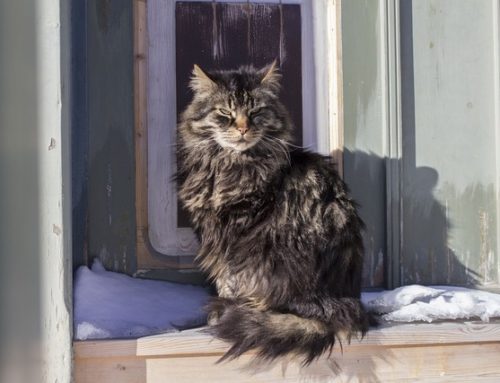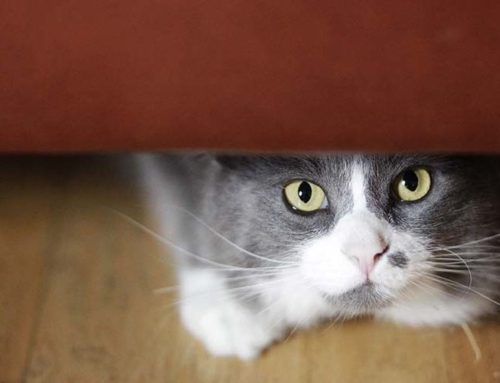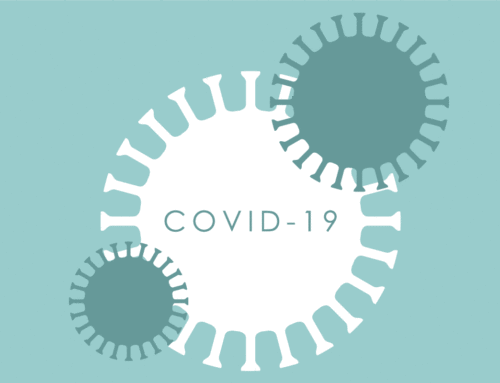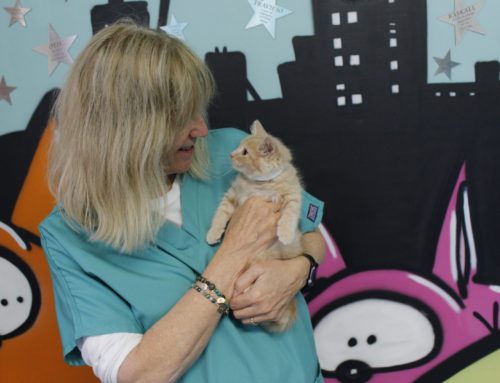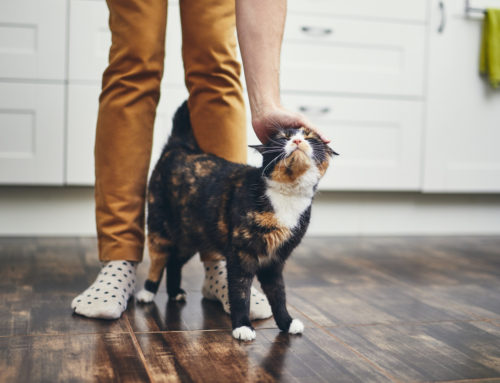Last week we had one very pretty, very pregnant momma cat who decided to deliver her kittens right there in the trap upon her arrival at our clinic!
First bit of good news, all five of the kittens came out healthy and strong. We then determined that momma cat was a friendly stray, which was the second bit of good news. She was very tame as can be and easy to handle, so the first-time trapper who had brought momma cat in decided to foster the new happy family until the kittens are big enough to wean and adopt out.
As a caregiver, if you ever find yourself in this situation, here are seven important things you need to remember when caring for a momma cat and her nursing newborns.
1) GIVE A GIRL SOME PRIVACY.
Momma cat and her babies should be set up in a room or area that is quiet and private, away from the hustle and bustle of the household. A spare bedroom or a bathroom works well, if you have the space. Taming cages also work, as do closets (if they are open and well ventilated). To make a bed for them, you can use a big basket bed, a medium-height cardboard box, or even an extra-large dog carrier. You’ll want enough room that mom can stretch out to nurse and edges high enough so that the babies don’t fall out. If the mom is feral or really skittish, you’ll probably want to keep her in a taming cage. The key is to make sure the area is private and clean. Keep the other animals in the household away from them. Also keep the area warm, as kittens can get chilled easily. If you put mom and her babies open in a spare bedroom, she may move her kittens around the room repeatedly. In the wild, this is how they protect them. Don’t worry too much about it; she will gather them all up to nurse.
2) FEED THE BEST QUALITY WET FOOD YOU CAN, AND LOTS OF FRESH WATER.
Momma cat will be doing most of the work, so you need to take good care of mom. She in turn will take care of the babies. Feed momma the best quality wet food you can; if you also feed dry, then leave some dry available for her. Mom needs lots of good quality wet food so that the babies get the best nourishment possible from her while they are in their growth phase. Kittens will nurse every 1-3 hours for the first three weeks. Only when they hit four or five weeks old will they be ready to start weaning off mom and onto wet food.
3) CLEANLINESS IS NEXT TO GODLINESS.
You’ll want to use bedding material that is soft yet washable; towels and fleece blankets work great. Change linens daily, especially in the first few weeks. One trick is to layer several layers of towels on the bed, so that you can take the dirty layer off the top and have a fresh set underneath. Make sure to keep the bedding area dry and warm.
4) FLEA CONTROL IS NOT A LITTLE THING.
Kittens can quickly get flea anemia, so it’s really important to keep momma, kittens and the bedding area flea-free.Use a flea product such as Revolution, Advantage or Frontline on mom only. Do not use flea products on newborn kittens; it’s not safe as they are too young. Instead, if you see fleas on the kittens, you can bathe them using Dawn dishwashing liquid and use a small flea comb as needed to get the fleas off. Avoid antibacterial soaps. If you have to bathe kittens, make sure you dry them well and keep them warm as they can get chilled easily.
5) USE A NON-CLUMPING CLAY LITTER (LIKE JOHNNY CAT).
Initially, mom will be the only one using the litter box. Kittens won’t start using a litter box until about four weeks old. Until them, mom will just lick them to stimulate them to go to the bathroom and then she’ll lick them clean. It’s best to use a non-clumping litter such as Johnny Cat while the kittens are nursing. Clumping litter works by clumping as soon as it gets wet — this can be dangerous to kittens because if they ingest any, it can clump in their intestines. Johnny Cat is a safe, cheap option until the kittens are old enough to know not to eat the litter. Also, keep the litter box away from the food bowls as much as possible (although we know sometime’s it’s tight in a taming cage).
6) CLOSELY MONITOR EVERYONE’S PROGRESS.
If you don’t have a lot of experience with nursing moms and kittens, it’s a good idea to bring momma cat and babies in to see a vet at around 1-2 weeks to make sure everyone is doing well. It’s very important that kittens are gaining weight steadily, so you’ll need to monitor their progress week over week. You’ll also want to FeLV/FIV test momma cat, because that will give you an indication of whether the babies will have FeLV or FIV. Everyone should also be dewormed for hookworms, roundworms and tapeworms, and also vaccinated. Check with your vet about the deworming and vaccination schedules.
7) HANDLE THE KITTENS EARLY TO SOCIALIZE THEM.
You can safely handle the kittens at any age. Momma cat might get a little panicky, so be considerate of her, but she isn’t going to reject the babies just because you touched them. Handling the kittens will ensure they grow up very tame and social, which will make it easier for you to find great homes for them. Just make sure you wash your hands before and after handling the kittens.
Momma cats can be fixed once their babies are 5 weeks old. At that age, kittens are eating on their own and going to the bathroom on their own, so they can be away from mom for a day while she gets fixed. If mom is feral, when the kittens are 5 weeks old, that is the point when you can get mom spayed and release her right where you trapped her. Kittens can be safely fixed as soon a they hit 2-3 lbs., which is generally between 8-12 weeks.
For more information on caring for newborn kittens and what to expect during each week of their growth, see Kitten Rescue’s web post “Kitten Care Handbook: The Basics.”


